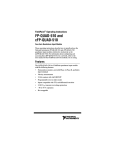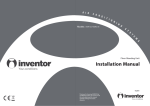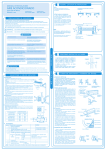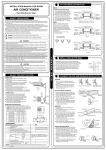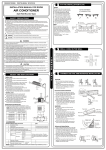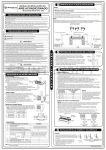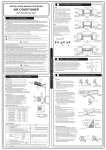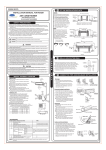Download National Instruments FP-QUAD-510 User's Manual
Transcript
OPERATING INSTRUCTIONS FP-QUAD-510 4-Axis, Quadrature Input Module These operating instructions describe the installation, features, and characteristics of the FP-QUAD-510. For details on configuring and accessing the FP-QUAD-510 over a network, refer to the user manual for the particular FieldPoint network module you are using with the FP-QUAD-510. Features The FP-QUAD-510 is a FieldPoint quadrature input module with the following features: • Four independent 32-bit position counters with individual Phase A, Phase B, and Index input terminals • Velocity measurement capabilities • Programmable reset on index mode • Sinking inputs, compatible with TTL or differential devices • Inputs protected to ±250 VDC • Hot plug and play operation • 2,500 Vrms input-to-output isolation • Double insulated for 250 V safe working voltage Power Requirement The FP-QUAD-510 is powered via the local backplane bus from the FieldPoint network module. The FP-QUAD-510 is a high-power consumption module and requires more than the nominal power allocated to an I/O module from the network module. In some applications, this could limit the number of I/O modules that you can connect to a single network module. FieldPoint™, National Instruments™, and ni.com™ are trademarks of National Instruments Corporation. Product and company names mentioned herein are trademarks or trade names of their respective companies. 322633B-01 © Copyright 2000 National Instruments Corp. All rights reserved. March 2000 When defining a FieldPoint system that uses an FP-QUAD-510 module, you must calculate the power consumption. First refer to the specifications section in the user manual for your network module. The maximum number of terminal bases per bank multiplied by 1 watt is the total power the network module can supply. For example, an FP-1000 or FP-1001 can support nine terminal bases (9 × 1 W = 9 W). Next, refer to the specifications section in the operating instructions for the I/O modules. Use the Power from Network Module specification. For example, a bank of modules consisting of four FP-QUAD-510 and five FP-DI-301 modules requires a total of 6.4 W from the FieldPoint network module [4 × (1.2 W) + 5 × (0.325 W) = 6.4 W]. This power requirement is less than the 9 W maximum and is therefore acceptable. Installation The FP-QUAD-510 mounts on a FieldPoint terminal base (FP-TB-xx) unit. Because of its hot plug and play operation, you can install the FP-QUAD-510 onto a powered terminal base without disturbing the operation of other modules or terminal bases. Although the FP-QUAD-510 receives operating power from the terminal base, the input circuitry requires an external power supply. To install your module, refer to Figure 1 and complete the following steps: 1. Slide the terminal base key to either position 8 (used for the FP-QUAD-510 module) or position X (used for any module). Note Although your module operates normally with the terminal base key in either position, you should use the position specifically for your module whenever possible. By doing so, you avoid accidentally plugging an incorrect module into a base once the base has been wired into the system. 2. Align the FP-QUAD-510 alignment slots with the guide rails on the terminal base. 3. Press firmly to seat the FP-QUAD-510 on the terminal base. When the module is firmly seated, the terminal base latch locks it into place. FP-QUAD-510 2 www.ni.com Key Latch Alignment Slot Guide Rails I/O Module Terminal Base Figure 1. Install Your Module Field Wiring The terminal base provides connections for each axis and for an external supply to power the FP-QUAD-510 input channels and field devices. The FP-QUAD-510 accepts two types of encoder signal inputs: single-ended (TTL) or differential line driver. Figure 2 shows the typical encoder wiring for differential signal input. Figure 3 shows the typical encoder wiring for single-ended signal input. Power for a +5 V encoder is also provided for each axis. If you require other encoder power voltages, reference an external supply to either the C terminal or the COM terminal. – C + V Encoder +5 V Reg Vsup +A –A +B –B +I –I COM +5 V +A –A +B –B +Index –Index GND Figure 2. Basic Field Connections to Differential Encoders © National Instruments Corp. 3 FP-QUAD-510 – C + V Encoder +5 V Reg Vsup +5 V +A –A NC +B –B NC +I –I NC +A +B +Index COM GND Figure 3. Basic Field Connections to Single-Ended Encoders The FP-QUAD-510 supports differential inputs for Phase A, Phase B, and Index signals. You can easily accommodate encoders with various phase relationships by swapping the signals and/or connecting them to the inverting inputs as specific applications require. The Index signal must occur when both the Phase A and Phase B signals are low, as shown in Figure 4. If the index polarity is inverted, try reversing the +Index and –Index signals on differential encoders or using the –Index input on single-ended encoders. Phase A Phase B Index Figure 4. Encoder Signal Phasing Table 1 lists the terminal assignments for the signals of each axis. +A and –A represent the Phase A signals, +B and –B represent the Phase B signals, and +I and –I represent the Index signals. FP-QUAD-510 4 www.ni.com Terminal assignments and wiring diagrams are also listed under the slide-in card on the front of the FP-QUAD-510 module. Table 1. Terminal Assignments Terminal Numbers Signal Axis 0 Axis 1 Axis 2 Axis 3 +A 1 5 9 13 –A 17 21 25 29 +B 2 6 10 14 –B 18 22 26 30 +I 3 7 11 15 –I 19 23 27 31 Vsup 4 8 12 16 COM 20 24 28 32 Status Indicators Figure 5 shows the module label and status indicators. Remove the slide-in card to see wiring diagrams for the input signals. Figure 5. Status Indicators After you insert the module into a terminal base (and apply power), the green POWER indicator lights and the FP-QUAD-510 informs the network module of its presence. When the network module recognizes the FP-QUAD-510, it sends initial configuration information to the FP-QUAD-510. After receiving this initial information, the green READY indicator lights and the FP-QUAD-510 is in its normal operating mode. © National Instruments Corp. 5 FP-QUAD-510 Position Counter Operation Each position counter has a 32-bit binary counter that represents the current position of the shaft connected to the axis. Channels 0 through 3 contain the lowest 16 bits of these counters for axes 0 through 3 respectively. Channels 4 through 7 contain the uppermost 16 bits for axes 0 through 3 respectively. Primarily, the position counter channels increment or decrement in response to edges encountered at the Phase A and Phase B inputs. The following sections describe the operation of the counter channels. Position Counter Input Circuit The circuit for the position counter inputs consists of a comparator with current limited inputs to convert from a differential to a single-ended signal. The output of the comparator is used to drive an optoisolator. When you apply a voltage above the threshold voltage to the input terminal, the comparator turns on the optoisolator, registering in the ON state. The inputs are designed to be compatible with single-ended TTL encoders or differential encoders supplying a differential voltage of at least ±0.3 V. Each encoder input has a lowpass filter that rejects frequencies above 250 kHz to reduce false counts due to high-speed transients. This cutoff point allows encoder frequencies as high as one million counts/second, because there are four counts per period, as shown in Figure 6. Phase A Phase B 00 10 11 01 1 period = 4 counts Figure 6. Quadrature Encoder Counts/Period Relationship FP-QUAD-510 6 www.ni.com Reset on Index Capability You can configure each position counter to reset each time the index condition is met. An index-initiated reset resets both the upper and lower 16-bit registers associated with that axis. This is useful in applications in which only the position within one rotation of the encoder is important to the user. In this mode of operation, any count errors that occur are canceled when the index condition is met. Commands Channels 0 through 3 (the lowest 16 bits of the position counter) each support a control command with one action—reset. The control-reset command resets the target counter. The control command ignores the index reset setting. This command also resets the upper 16 bits of the position counter. Velocity Data Channel Operation The FP-QUAD-510 uses a timebase counter as a basis for determining the rate of change of position—the velocity—for each axis. The four velocity data registers, channels 8 through 11, contain 16-bit velocity data for axes 0 through 3 respectively. The data in each register represents the velocity of the axis in number of counts per microsecond. A positive number indicates motion in the forward direction, and a negative number indicates motion in the reverse direction. Each register can be independently programmed with one of eight velocity ranges as shown in Table 2. Each range is based on a different timebase length and has a different resolution. Note While the ranges available reach speeds of 160 counts per microsecond, the module inputs are still limited to 1,000,000 counts per second (1 count per microsecond) maximum. The higher ranges are used to measure velocity over shorter timebases. With these ranges, the velocity data is averaged over a much shorter time period and, therefore, is more instantaneous. However, the data from these ranges has a coarser resolution. The slower ranges have a finer resolution, but the data is an average velocity over a longer period of time. © National Instruments Corp. 7 FP-QUAD-510 Table 2. Velocity Ranges Length of Timebase (in µs) Velocity Range (in counts/µs) Velocity Resolution 204.8 ±160 4.883 counts/ms 409.6 ±80 2.441 counts/ms 819.2 ±40 1.221 counts/ms 1638.4 ±20 610.4 counts/s 3276.8 ±10 305.2 counts/s 6553.6 ±5 152.6 counts/s 13107.2 ±2.5 76.29 counts/s 26214.4 ±1.25 38.15 counts/s The velocity range is the maximum velocity that can be measured for a given timebase. The velocity register uses a 15-bit counter, which gives a maximum number of counts of 215, or 32,768. So, the velocity range for a given timebase is calculated using the following formula: ± 32768 V rng = -----------------T where Vrng is the velocity range in counts per microsecond and T is the timebase in microseconds. The velocity resolution is the velocity accuracy for a given timebase and is determined using the following formula: 1000 V res = -----------T where Vres is the velocity resolution in counts per millisecond and T is the timebase in microseconds. Index Status Channel Operation The FP-QUAD-510 includes four discrete input channels, channels 12 through 15, which contain the status of the Index signal for axes 0 through 3 respectively. This signal is latched to a 1 when the condition at the axis inputs is Phase A = 0, Phase B = 0, and Index = 1. This bit remains latched until it is read, at which point it is cleared automatically. FP-QUAD-510 8 www.ni.com Note If the axis is stopped with the index condition true, then reading the status bit causes the bit to reset to 0. However, since the index condition is still true, the bit is immediately latched back to 1. If the Reset on Index attribute (see Position Counter Operation) is selected, then the index status bit does not need to be read between successive index pulses in order for the position counters to reset. The position counters respond to index pulses as programmed regardless of the state of the index status bit. Isolation and Safety Guidelines Before you connect any circuits that may contain hazardous voltages to the FP-QUAD-510, read the following information. Caution This section describes the isolation of the FP-QUAD-510 and its compliance with international safety standards. The field wiring connections are isolated from the backplane provided by the terminal base with an optical and galvanic isolation barrier designed and tested to provide protection against fault voltages of up to 2,500 Vrms. In addition, the FP-QUAD-510 provides double insulation (compliant with IEC 1010-1) for working common-mode voltages of 250 Vrms. Safety standards (such as those published by UL and IEC) require the use of double insulation between hazardous voltages and any human-accessible parts or circuits. Never try to use any isolation product between human-accessible parts (such as DIN rails or monitoring stations) and circuits that may be at hazardous potentials under normal conditions, unless the product is specifically designed for such an application, as is the FP-QUAD-510. When you use a product like the FP-QUAD-510 in applications with hazardous potentials, follow these guidelines to make sure your total system is safe: • The safety isolation of the FP-QUAD-510 is from input to output, not between channels on the same module. If any of the channels on a module are wired at a hazardous potential, make sure that all other devices or circuits connected to that module are properly insulated from human contact. • Do not share the external supply voltages (V and C on the terminal base) with other devices (including other FieldPoint devices), unless those devices are isolated from human contact. © National Instruments Corp. 9 FP-QUAD-510 • • As with any hazardous voltage wiring, make sure that all wiring and connections meet applicable electrical codes and common sense practices. Mount terminal bases in an area, position, or cabinet that prevents accidental or unauthorized access to wiring that carries hazardous voltages. The isolation of the FP-QUAD-510 is certified as double-insulated for normal operating voltages of 250 Vrms. Do not use the FP-QUAD-510 as the only isolating barrier between human contact and working voltages of more than 250 Vrms. Channel Operation Summary Table 3 summarizes the functionality of each of the FP-QUAD-510 channels as accessed through FieldPoint Explorer or other software. Table 3. FP-QUAD-510 Channel Operation Summary Channel No. Channel Description Type Range 0 Axis 0 Position LSW Count Input 0–65535 1 Axis 1 Position LSW Count Input 0–65535 2 Axis 2 Position LSW Count Input 0–65535 3 Axis 3 Position LSW Count Input 0–65535 4 Axis 0 Position MSW Count Input 0–65535 5 Axis 1 Position MSW Count Input 0–65535 6 Axis 2 Position MSW Count Input 0–65535 7 Axis 3 Position MSW Count Input 0–65535 8 Axis 0 Velocity Analog Input 8 ranges 9 Axis 1 Velocity Analog Input 8 ranges 10 Axis 2 Velocity Analog Input 8 ranges 11 Axis 3 Velocity Analog Input 8 ranges 12 Axis 0 Index Active Discrete Input Boolean 13 Axis 1 Index Active Discrete Input Boolean 14 Axis 2 Index Active Discrete Input Boolean 15 Axis 3 Index Active Discrete Input Boolean FP-QUAD-510 10 www.ni.com Specifications The following specifications are typical for a range of –40 to +70 °C, unless otherwise noted. Encoder Input Number of channels.......................... 4 Input type Single-ended............................... VIL = 0.0–0.8 V VIH = 2.0–250.0 V Differential ................................. ±0.3 V provided one input falls between 0.0 and 3.0 V and the other input falls between 0.0 and 250 V Maximum protected input voltage.... ±250 VDC on each input Input bandwidth ................................ 250 kHz for each input Encoder frequency ............................ 1 million counts/second Minimum input pulse width.............. 2 µs Isolation ............................................ 2,500 Vrms Safety isolation, working voltage ..... 250 Vrms, designed per IEC 1010 as double insulated External supply voltage (V).............. 8 to 30 VDC, user-provided at 5 W I/O supply voltage (Vsup) ................ 5 VDC at 600 mA maximum Physical Indicators .......................................... Green POWER and READY indicators Weight............................................... 143 g (5.1 oz.) Power Requirements Power from network module ............ 1.2 W maximum Environment Operating temperature ...................... –40 to +70 °C Storage temperature .......................... –55 to +85 °C Relative humidity.............................. 5% to 90%, non-condensing © National Instruments Corp. 11 FP-QUAD-510 CE Mark Compliance This product meets applicable EU directive(s), as follows: Safety isolation ................................ EN 61010 (double insulation for 250 Vrms working isolation, installation category II) EMC directive Immunity .................................... EN 50082-1:1994 Emissions .................................. EN 55011:1991 Group I Class A at 10 m Mechanical Dimensions Figure 7 shows the mechanical dimensions of the FP-QUAD-510 installed on a terminal base. Dimensions are given in inches [millimeters]. 4.22 [107.19] 4.31 [109.5] 3.60 [91.44] Figure 7. Mechanical Dimensions












